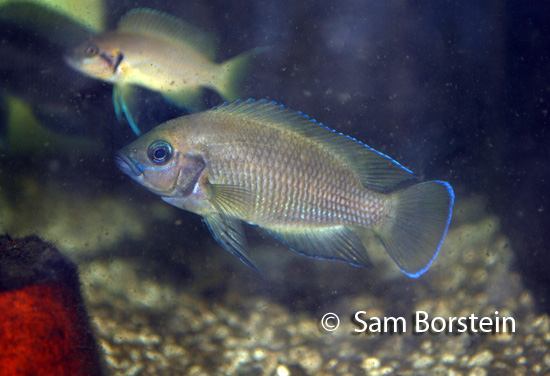Variabilichromis moori
(Boulenger, 1898)
Synonyms: Lamprologus moori, Neolamprologus moori

Above: Variabilichromis moori. Photo by Sam Borstein.
Etymology:
Genus- Variabil= variable (Latin), chromis= a fish, perhaps a perch (Greek).
Species- moori= named after J. E. S. Moore.
Intro:
Variabilichromis moori was first typed by Boulenger in 1898. This colorful and interesting Lamprologine is actually named in honor of J. E. S. Moore, who was one of the first collectors of cichlids. This fish is a beautiful black color with gorgeous light blue fin edges.
Distribution:
Variabilichromis moori are found in the southern rocky areas of Lake Tanganyika.
Size, Maturity, and Sexual Dimorphism:
Size: Males- 4 inches, Females- 5 inches
Maturity: 3 inches
Sexual Dimorphism: Females are larger than males. Males may have longer fins.
Care:
Variabilichromis moori is small, but very aggressive. They will do fine in a community tank, as long as they are put with fish with similar requirements that are bigger, and can hold their own. Members of the Pseudotropheus genus work well for this.Tank should be decorated with lots of caves and hiding spots. This fish is best kept in pairs.
Diet:
Variabilichromis moori is a carnivore. Make sure it gets food with lots of protein. They especially love brine shrimp.Breeding:
Variabilichromis moori can be hard to spawn. The key is putting them in with other fish that is spawning. With the hormones in the water, they will spawn. Many have had the same experience and the reason for this is in the wild Variabilichromis moori need to spawn when another Lamprologine, Neolamprologus mustax spawns. The fry and juveniles of Variabilichromis moori are yellow and exactly the same color as Neolamprologus mustax. What Variabilichromis moori does is it spawns and then leaves its fry with Neolamprologus mustax pairs breeding close by (Konings, 1998). This way the adults don't have to spend energy and resources raising a brood.
In aquaria Variabilichromis moori make fine parents. They spawn in a very secluded area. When mine spawned, I actually had no idea until I saw the fry. Up to 300 small eggs are laid. A week later they are free swimming. The fry are really tiny, but large enough to eat baby brine shrimp. They grow relatively fast.
Conclusion:
This is a cool fish. It is probably only for a Tanganyikan fan though. You'll need to go to a hobbyist to find this fish as it is not usually in stores.
References:
- Boulenger, G. A. (1898). Report on the fishes recently obtained by Mr. J. E. S. Moore in Lake Tanganyika. Proceedings of the Zoological Society of London, 494-497.
- Konings, A. (1998) Tanganyikan cichlids in their natural habitat. Cichlid Press, El Paso, Texas, 272 pp.
